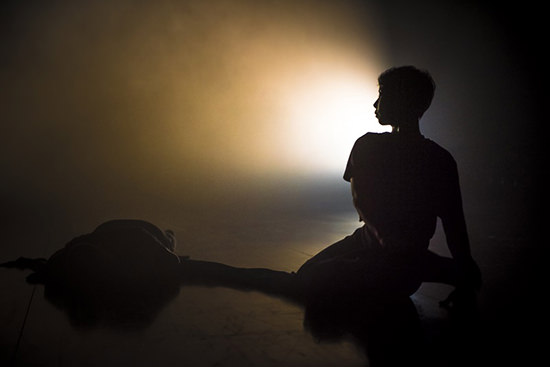Next Wave Festival: “How did that make you feel?”
Elyssia Bugg: Admission Into The Everyday Sublime

Admission Into The Everyday Sublime, Next Wave 2016
photo Gregory Lorenzutti
Admission Into The Everyday Sublime, Next Wave 2016
The audience files into Admission Into The Everyday Sublime, to find themselves entering a work already in progress. Four dancers move through the smoke-filled space, administering light pressure to the spines of their counterparts, jogging when the desire appears to overcome them, wrestling vigorously with one another only to mutually yield. It’s a scene of wellness-seeking that the audience is eased into tenderly through the softening of spatial and temporal boundaries.
In her 2016 book, Cure Jo Marchant investigates alternate healing practices, positing that the more time a practitioner spends with their patient, the more likely it is that the patient will feel better on leaving the clinic. Like Marchant, Lilian Steiner’s latest work is similarly concerned with restorative practices, drawing on everything from tai chi to crystal healing to yoga in an ever more abstract evocation of the question, “and how does it make you feel?”
Throughout this process, Steiner applies time, or rather, duration as a kind of salve. It is used liberally and as a means of elevating the atmosphere of the work to a higher, meditative state. In an extended phrase in which red light fills the space, the two male performers, heads tilted slightly, turn on the spot like slow-motion Dervishes. Each cradles a rock in the palm of a raised hand, axis points within the repetitious spinning. This sequence is drawn out to what feels like an age, yet it never truly achieves the revelatory quality that the work’s title suggests. Instead the incremental nature of the choreography drove me to distraction.
Perhaps unfortunately, the visual proximity of other bodies in the room provides ample means of diversion. Steiner has arranged the space traverse style with two seated rows on either side. The audience is consequently always looking, consciously or unconsciously, at their counterparts on the opposite side of the room. Though it promotes a sense of connectivity and an awareness of one’s own body, it is of a body, bodies, on the outside of the work—admission into the everyday sublime without the option of complete submission.
There are simple aesthetic moments, near-still images through which the work touches on the title’s promise of transcendence. In one phrase the four dancers stand backlit in the dense white fog, so that the negative space that rings them becomes a kind of aura. In another the dancers oscillate minutely, leaning at alien angles as a deep, bass note reverberates through the space. These moments are beautiful, but largely unmoving.
The work culminates with the dancers retreating to settle atop individual plinths, their bodies lit from above. Four humours, or temperaments, unmoving except for the two male performers, who sit behind laptops, one with microphone in hand emitting a heavily distorted gurgling. As the phrase stretches on, the score bloating with intensity, a painting at the opposite end of the space comes into focus. Using the grand dimensions of the room to advantage, the image stretches nearly floor to ceiling. Slowly, in keeping with the meter of Steiner’s work, the light transforms the image from carnal red to exultant gold. As the house lights come up and the dancers exit discreetly, it fades to dull metallic grey. The doors open, but the score continues; the audience waits, uncertain whether this is their cue to leave. After a time they applaud and confusedly file out, the temporal environment of the piece once again tapering to a point outside of my involvement.
Endurance has the potential to bring one closer to the divine. People seek it out in the form of physical challenge, religious experience and art. Yet time, and the ability to withstand great undiluted doses of it, is not a cure-all. It cannot necessarily alleviate the recurrent symptoms of exhaustion that are produced by the actively languid. That requires some level of preconceived belief in the effectiveness of the practice. As I left the venue I dwelt on the question, “and how did that make you feel?” only to come up blank but for the conclusion that I felt nothing much at all.
Next Wave Festival 2016: Admission Into The Everyday Sublime, choreographer Lilian Steiner, performers Atticus Bastow, Briarna Longville, Jonathon Nokes, Lilian Steiner, sound Atticus Bastow, Jonathon Nokes, lighting Matthew Adey, costumes Shio Otani, commissioned artwork Ash Keating; Arts House, North Melbourne, 18-22 May
Elyssia Bugg is a Melbourne-based writer, filmmaker and dance teacher. Her writing has appeared in Voiceworks, Lip Magazine and the RMIT Creative Writing Anthology. She is currently working on a short film about aliens and oblivion.
This review was written in the DanceWrite dance reviewing workshop. Read more reviews here.
DanceWrite was conducted by RealTime editors Virginia Baxter and Keith Gallasch with mentors Andrew Fuhrmann and Jana Perkovic. The workshop was an initiative of Hannah Matthews as part of her Australia Council-funded Sharing Space program and was presented in collaboration with Next Wave and RealTime.
RealTime issue #132 April-May 2016 pg.






